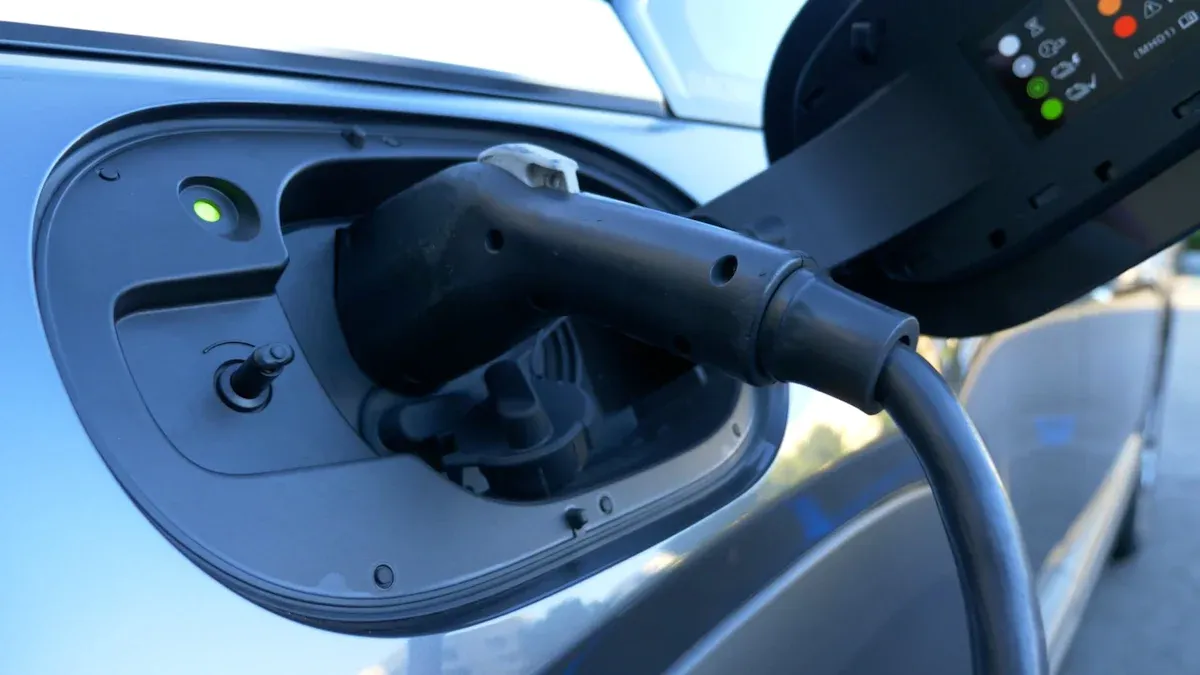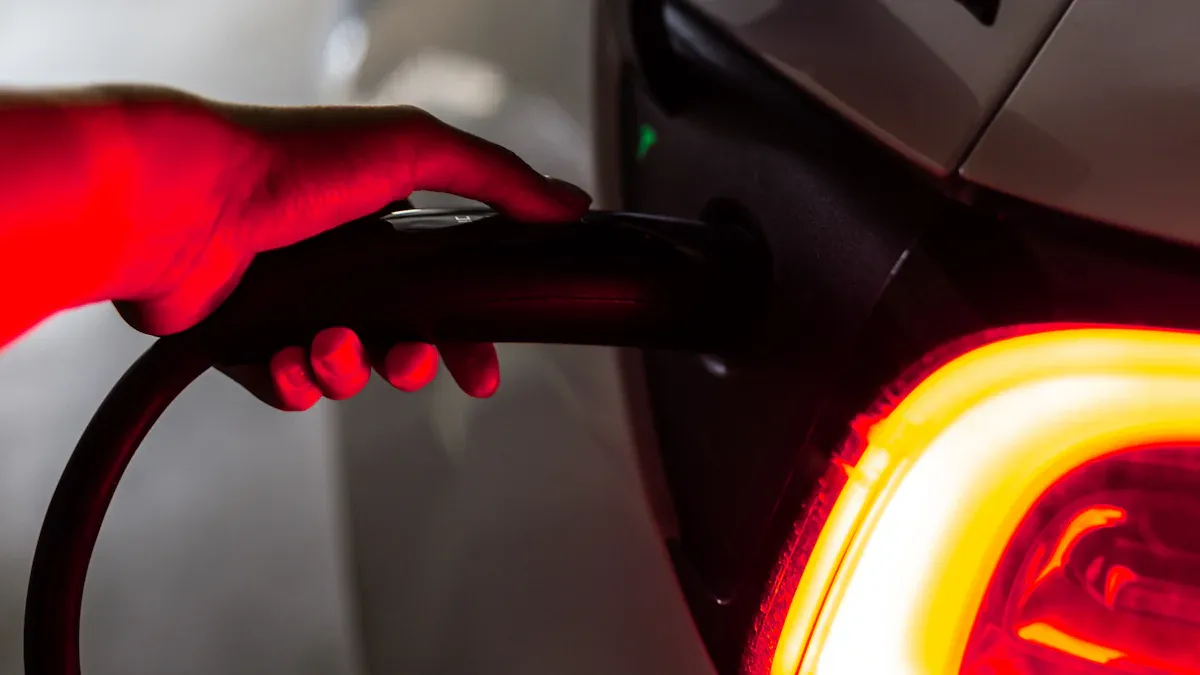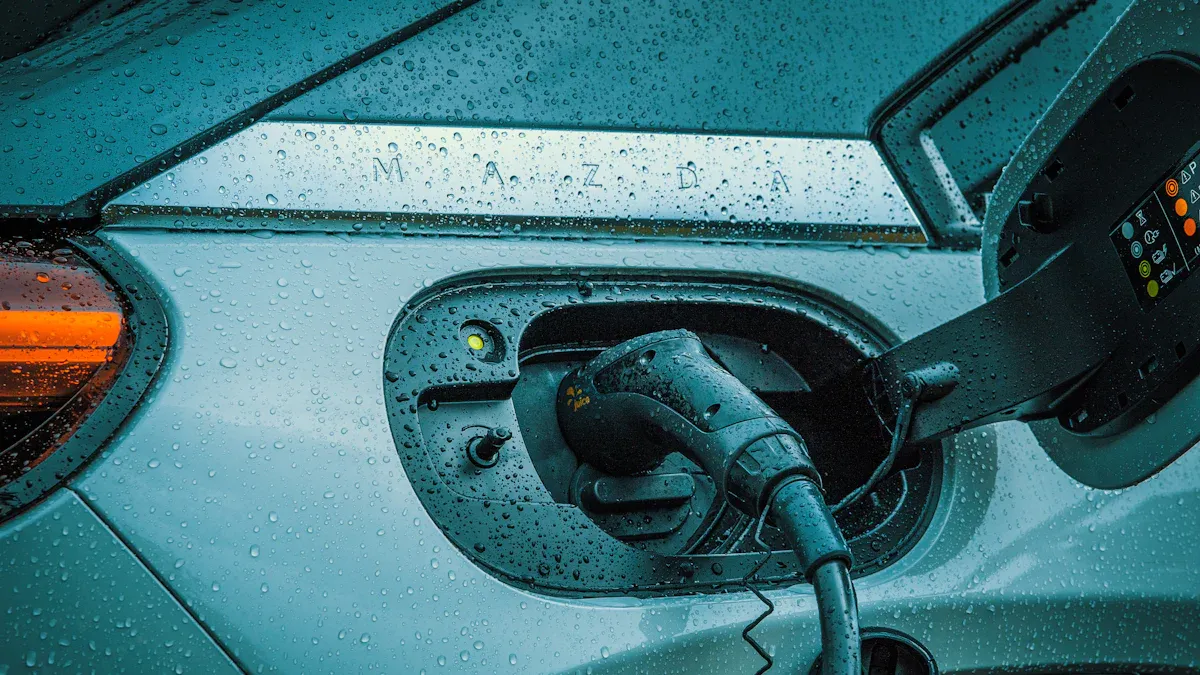
Lightweighting plays a crucial role in making your electric vehicle more efficient and sustainable. By reducing the weight of battery systems, you can enhance energy efficiency and extend driving range. For instance, lightweight materials can shrink battery size by about 5%, which directly boosts efficiency and range. Additionally, lighter vehicles use less energy per kilometer, lowering the need for large batteries and conserving valuable resources. As vehicle weights continue to rise globally, lightweighting strategies help counter this trend, ensuring a greener future while meeting consumer demands for longer ranges and better performance.
Reducing the mass of a battery electric vehicle directly improves its energy efficiency and driving range. Lightweighting strategies play a pivotal role in this process. For example:
- A 10% reduction in vehicle weight can enhance energy efficiency by 6-8%.
- Replacing traditional materials with lightweight options can reduce vehicle weight by up to 50%, significantly lowering energy consumption.
Lighter vehicles require less energy to accelerate, which means you can travel farther on a single charge. This improvement not only boosts performance but also reduces the need for larger, heavier batteries, creating a positive cycle of efficiency.
Range anxiety remains one of the biggest barriers to widespread electric vehicle adoption. Many drivers worry about running out of power during trips. In fact:
- 58% of drivers cite range anxiety as a key concern when considering an EV.
- Although 65% of EV drivers initially experience range anxiety, this concern diminishes over time.
Lightweighting helps alleviate this issue by extending the driving range of EVs. With the average range of U.S. electric cars reaching 291 miles in 2022, lightweighting ensures that more of your daily driving needs—over 95% of which require less than 100 miles—can be met with confidence. Additionally, as charging infrastructure continues to grow, lightweight EVs will become even more practical for long-distance travel.
Lightweighting contributes significantly to sustainability by reducing the environmental impact of EVs. Lighter vehicles consume less energy, which means fewer resources are needed to produce and charge batteries. This reduction in energy demand aligns with global efforts to lower carbon emissions. Furthermore, using advanced lightweight materials, such as aluminum and composites, reduces the reliance on traditional, resource-intensive materials. By adopting these strategies, you can help drive the transition to a more sustainable future while enjoying the benefits of improved vehicle performance.
Innovative materials play a crucial role in lightweighting strategies for battery electric vehicles. By replacing traditional materials with advanced lightweight options, you can achieve significant weight reduction and improve energy efficiency.
By adopting these materials, you can optimize the performance of your electric vehicle while supporting sustainability goals.
Structural design plays a vital role in lightweighting. Engineers use advanced techniques to create battery systems that are both lighter and more efficient.
| Study Title | Key Findings | Performance Metrics |
|---|---|---|
| Design of Lightweight Structures | Focus on lightweight battery systems and structural optimizations | Discharge capacity: 117 mAh g-1, Energy storage efficiency: 96.8% after 300 cycles |
| Multi-Material Conceptual Design | Development of multimaterial topology optimization for lightweight aerospace structures | Enhanced design efficiency and material distribution |
| Structural assessment of electric two-wheeler battery enclosure | Optimization of battery pack enclosure for electric vehicles | Reduced mass with polymer materials, improved structural stability |
These strategies ensure that your battery system remains lightweight while maintaining durability and safety.
Manufacturing innovations enable the production of lightweight components with precision and efficiency. These techniques are essential for implementing lightweighting strategies at scale.
These manufacturing techniques empower you to achieve significant weight reduction while maintaining high standards of performance and sustainability.

Aluminum and magnesium are two of the most effective lightweight materials for electric vehicle (EV) battery systems. These metals offer high strength-to-weight ratios, making them ideal for reducing the overall mass of your EV without compromising durability. Aluminum alloys, for example, can replace heavier steel components, cutting weight by up to 50%. Magnesium, being 33% lighter than aluminum, is another excellent choice for lightweighting. Its use in battery enclosures and structural parts ensures both strength and thermal stability. By incorporating these metals, you can achieve significant weight reduction, which directly improves energy efficiency and driving range.
Composite materials are revolutionizing the design of EV battery systems. These materials combine strength, flexibility, and lightweight properties, making them indispensable for modern EVs. For instance:
- Composites reduce vehicle weight while maintaining strength and stiffness.
- Carbon nanotube integration increases electrical current capacity by up to 14%.
- They help manage battery temperature, enhancing efficiency and lifespan.
- Acting as electrical insulators, composites ensure safety in EVs.
- Glass-reinforced composites offer cost advantages over metals like aluminum and titanium.
One notable example is the BOLDair composite battery enclosure, originally developed for aviation. It weighs just 52 kg and achieves a specific energy of 285 Wh/kg, showcasing the potential of advanced composites in lightweighting.
| Evidence Type | Description |
|---|---|
| Composite Battery Enclosure | BOLDair, designed for aviation, meets mechanical and high-voltage demands. |
| Performance | The battery weighs 52 kg with a specific energy of 285 Wh/kg. |
Solid-state batteries represent the next frontier in lightweighting. These batteries replace traditional liquid electrolytes with solid ones, eliminating the need for bulky components. This innovation reduces weight while increasing energy density and safety. Solid-state materials also allow for thinner and more compact designs, which optimize space and further reduce mass. By adopting this technology, you can enhance your EV's performance and sustainability. As research progresses, solid-state batteries will likely become a cornerstone of lightweight EV design.
Integrating multiple functions into a single component can significantly reduce the mass of your EV battery system. This approach eliminates the need for additional parts, streamlining the design and improving efficiency. For example, a multi-load and multi-source DC-DC converter can combine a primary battery with a secondary solar source. This integration ensures stable power distribution and eliminates cross-regulation issues. It also maintains output voltage deviations within ±1%, achieving an impressive 93% efficiency under variable load conditions.
| Feature | Description |
|---|---|
| Converter Type | Multi-Load and Multi-Source DC-DC converter |
| Energy Sources | Integrates primary battery and secondary solar source |
| Key Benefits | Eliminates cross-regulation issues, stable power distribution, independent control of loads |
| Efficiency | Achieved 93% under variable load conditions |
| Output Stability | Maintains output voltage deviations within ±1% |
| Application | Suitable for EVs and other industries requiring reliable power distribution |
This strategy not only reduces mass but also enhances the overall reliability of your EV.
Modular and compact designs optimize the layout of your battery system, leading to significant weight reduction. Modular designs allow you to assemble battery packs with fewer components, while compact layouts maximize space efficiency. Research shows that optimized battery pack enclosures can achieve up to a 43.25% reduction in weight. For instance, studies on aluminum alloy battery pack shells demonstrate improved crash safety and reduced stress under load-bearing conditions.
| Study | Findings | Weight Reduction |
|---|---|---|
| Zheng et al. | Optimized battery pack enclosure using finite element analysis | 43.25% reduction (from 110.56 kg to 62.74 kg) |
| Zhang et al. | Optimized structure to mitigate stress and deformation | Improved crash safety with reduced stress and deformation |
| Gao et al. | Topology optimization of module end plates | Total weight reduction of 15.22 kg (19.82% reduction) |
| Jin et al. | Structural design of aluminum alloy battery pack lower shell | Optimized design under load-bearing conditions |
| Wang et al. | Cross-section design for aluminum alloy protective structures | Weight reductions of 59.6% and 46.8% compared to original steel structure |
By adopting modular and compact designs, you can achieve both mass reduction and improved safety.
Topology optimization uses advanced mathematical models to determine the best material distribution for your battery system. This technique minimizes unnecessary material while maintaining structural integrity. For example, engineers have used topology optimization to design module end plates, achieving a 19.82% reduction in weight. This method ensures that every component contributes to the system's performance without adding excess mass.
By applying topology optimization, you can achieve significant weight reduction while maintaining the durability and safety of your EV battery system.
Additive manufacturing, or 3D printing, offers you a powerful way to create lightweight components for EV battery systems. This technique builds parts layer by layer, allowing for intricate designs that traditional methods cannot achieve. You can use it to produce custom battery enclosures and structural components with minimal material waste.
By adopting additive manufacturing, you can achieve lighter, safer, and more efficient battery systems while keeping costs under control.
High-precision casting and forming techniques allow you to create lightweight metal components with exceptional accuracy. These methods are ideal for shaping materials like aluminum and magnesium, which are commonly used in EV battery systems.
For example, precision casting ensures that every part meets exact specifications, reducing the need for additional machining. Forming processes, such as hydroforming, stretch materials into complex shapes without adding unnecessary weight. These techniques maximize the strength-to-weight ratio of components, ensuring durability while minimizing mass.
Using high-precision casting and forming, you can produce lightweight parts that meet the highest standards of performance and safety.
Artificial intelligence (AI) is transforming the way you design and manufacture lightweight components. AI tools analyze data to identify the most efficient designs and manufacturing processes. This technology helps you optimize material usage, reduce production time, and maintain consistent quality.
For instance, AI-driven software can simulate how materials will behave under different conditions. This allows you to test and refine designs before production, saving time and resources. Automation further enhances efficiency by streamlining repetitive tasks and ensuring precision.
By leveraging AI and automation, you can stay ahead in the race to develop innovative, lightweight EV battery systems. These tools not only improve performance but also make the manufacturing process more sustainable.
Lightweighting strategies significantly enhance the performance and range of your electric vehicle. By reducing the mass of the vehicle, you can achieve better energy efficiency and extend the distance you can travel on a single charge. For instance, studies show that lightweighting can reduce the mass of battery electric vehicles by 28 to 36%. This reduction directly translates to a driving range increase of 36.4 to 46.8%. Such improvements not only make your vehicle more efficient but also address range anxiety, a common concern among EV drivers.
When your vehicle weighs less, it requires less energy to accelerate and maintain speed. This means you can rely on a smaller battery, which further reduces weight and enhances efficiency. The cycle of weight reduction and improved energy efficiency creates a vehicle that performs better while consuming fewer resources. This approach aligns with global sustainability goals, ensuring that your vehicle contributes to a greener future.
While lightweighting offers numerous benefits, it also presents challenges, particularly in terms of cost and scalability. Advanced materials like carbon fiber composites and lightweight metals such as magnesium often come with higher production costs. These materials require specialized manufacturing processes, which can increase the overall expense of producing lightweight components.
Scalability is another critical factor. For lightweighting strategies to become widespread, manufacturers must find ways to produce these materials and components at scale without compromising quality. Innovations in manufacturing, such as additive manufacturing and AI-driven automation, are helping to address these challenges. By adopting these technologies, you can reduce production costs and make lightweighting more accessible for mass-market electric vehicles.
However, balancing cost, scalability, and performance remains a delicate task. As the demand for electric vehicles grows, the industry must continue to innovate and invest in cost-effective solutions that support lightweighting without sacrificing affordability.
Safety and durability are essential considerations when implementing lightweighting strategies. While reducing mass can improve performance, it is crucial to ensure that the materials and designs used in your vehicle meet strict safety standards. Lightweight materials like aluminum and composites offer excellent strength-to-weight ratios, but they must be carefully engineered to withstand the stresses of daily use.
For example, battery enclosures made from composite materials provide both weight reduction and enhanced safety. These enclosures can resist corrosion, manage heat effectively, and even offer flame resistance, ensuring the safety of your vehicle's battery system. Additionally, advanced structural designs, such as modular and compact battery packs, improve crash safety by distributing impact forces more effectively.
Durability is equally important. Lightweight components must endure the rigors of long-term use without degrading in performance. Engineers use techniques like topology optimization to ensure that every part of your vehicle is designed for maximum strength and efficiency. By prioritizing safety and durability, you can enjoy the benefits of lightweighting without compromising on reliability.

Leading EV manufacturers have embraced lightweighting strategies to improve vehicle performance and efficiency. Tesla, for instance, uses aluminum extensively in its battery enclosures and vehicle frames. This approach reduces weight while maintaining structural integrity. Similarly, BMW’s i3 model incorporates carbon fiber-reinforced polymers in its body, achieving a 50% weight reduction compared to traditional steel. These innovations enhance energy efficiency and extend driving range.
Another example is Lucid Motors, which integrates lightweight materials and modular battery designs in its vehicles. This strategy allows for compact battery packs that maximize space and reduce overall mass. By adopting these techniques, manufacturers not only improve vehicle performance but also address consumer concerns like range anxiety.
Collaboration between industries and research institutions drives advancements in lightweighting. For example, partnerships between automakers and material science companies have led to breakthroughs in graphene battery technology. This innovation improves charge cycles by three times and boosts conductivity by 200%, enhancing battery efficiency.
Government-funded projects also play a crucial role. Initiatives like the U.S. Department of Energy’s Lightweight Materials Program support the development of advanced materials such as silicon anodes. These anodes increase battery capacity by up to 40%, enabling longer-lasting batteries for battery electric vehicles. Such collaborations accelerate the adoption of lightweighting strategies, making EVs more efficient and sustainable.
| Advancement | Impact on Performance |
|---|---|
| Lithium-sulfur technology | Gaining traction in labs, promising real-world adoption, enhancing energy density and performance. |
| Graphene battery technology | Improves charge cycles by three times and boosts conductivity by 200%, enhancing overall battery efficiency. |
| Cobalt-free batteries | Reshapes market economics and competitiveness, leading to cost-effective solutions for EVs. |
| Increased charge cycles | Jump from 1,500 to over 5,000 cycles reduces total cost of ownership and boosts consumer confidence. |
| Silicon anodes | Increases battery capacity by up to 40%, leading to longer-lasting batteries for EVs. |
| Plummeting lithium-ion prices | Makes EVs more affordable, driven by manufacturing efficiency and reduced reliance on expensive materials. |
| Growing battery demand | Expected to grow tenfold by 2030, driven by government incentives and consumer demand for EVs. |
Lightweighting strategies have revealed valuable lessons for the EV industry. One key takeaway is the importance of balancing weight reduction with safety and durability. Lightweight materials like composites and aluminum must meet strict safety standards to ensure reliability.
Another best practice involves integrating lightweighting into the design phase. By considering weight reduction early, manufacturers can optimize material usage and structural design. Modular battery packs, for example, simplify assembly and reduce mass.
Finally, ongoing innovation is essential. Technologies like cobalt-free batteries and lithium-sulfur systems promise to reshape the industry. These advancements lower costs and improve performance, making EVs more accessible to consumers. By adopting these practices, you can contribute to a sustainable future while enjoying the benefits of lightweight, efficient vehicles.
Lightweighting strategies transform electric vehicles by improving efficiency, extending range, and supporting sustainability. By reducing the mass of battery systems, you can create vehicles that consume less energy and perform better. These advancements align with global efforts to protect the environment.
Ongoing innovation and collaboration remain essential. Researchers and manufacturers must work together to develop new materials and designs. This teamwork ensures that lightweighting continues to evolve.
Looking ahead, lightweighting will play a key role in achieving sustainability goals. As technology advances, you can expect electric vehicles to become even more efficient and eco-friendly.
Lightweighting reduces the weight of electric vehicles by using advanced materials and designs. It improves energy efficiency, extends driving range, and supports sustainability. By making your EV lighter, you can travel farther on a single charge and reduce environmental impact.
Lightweight materials like aluminum and composites lower the overall mass of your EV. This reduces energy consumption and enhances driving range. These materials also maintain strength and durability, ensuring safety while improving efficiency.
Yes, lightweight components undergo rigorous testing to meet safety standards. Materials like composites resist corrosion and manage heat effectively. Engineers also use advanced designs, such as modular battery packs, to ensure durability and crash safety.
Lightweighting can reduce long-term costs by improving energy efficiency and lowering battery size requirements. While advanced materials may increase initial costs, innovations like AI-driven manufacturing are making lightweighting more cost-effective for mass production.
AI optimizes designs and manufacturing processes for lightweight components. It analyzes data to create efficient designs, reduces production time, and ensures consistent quality. By using AI, you can achieve better performance and sustainability in your EV.